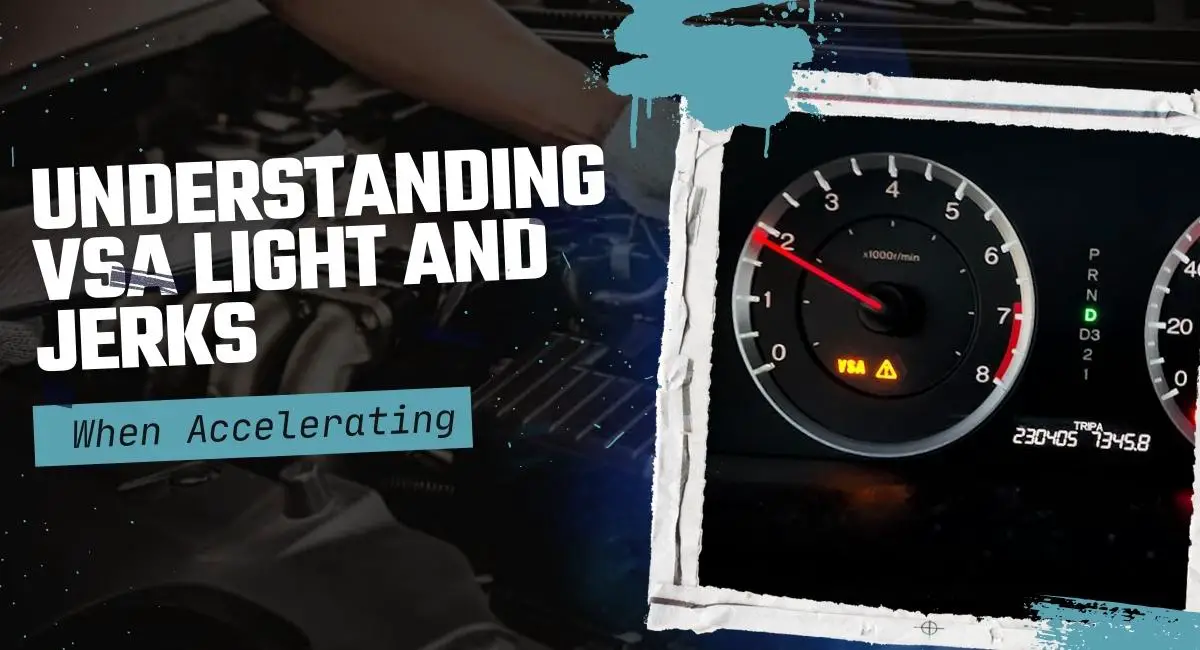Modern vehicles are akin to complex pieces of art, housing numerous intertwined systems that work in unison to ensure a seamless, safe, and efficient driving experience. Among these, Vehicle Stability Assist (VSA) plays a cardinal role in maintaining a car’s stability during various driving conditions.
When the VSA light comes on while accelerating, it indicates that there may be an issue with your car’s stability control system. The VSA system’s design is to help maintain traction and stability during various driving conditions, including acceleration, cornering, and slippery roads.
But what does it mean when the car starts to jerk while accelerating, and the VSA light shines brightly on your dashboard? This comprehensive guide aims to help you decipher these signs, mainly focusing on the scenario when your car jerks while accelerating and the VSA light comes on.

Understanding the Vehicle Stability Assist (VSA) in a Car
The VSA, or Vehicle Stability Assist system, is an ingenious technology built into many modern cars, particularly those manufactured by Honda and Acura. It is a safety feature that keeps your vehicle from skidding, understeering, or oversteering during harsh driving conditions or sudden maneuvers. Automatically adjusting brake pressure and engine power to the wheels helps the driver maintain control and stability.
When the VSA light illuminates your car’s dashboard, it can signify two situations. Firstly, it may indicate that the VSA system is engaged and actively stabilizing your vehicle. Secondly, worryingly, it can signal an issue with the VSA system.
Explain How the VSA Functions
The Vehicle Stability Assist (VSA) system enhances the driver’s control over the car, especially during unfavorable driving conditions or when executing sudden maneuvers. Here’s how the VSA system functions:
Monitoring Vehicle Behavior
The VSA system continuously monitors various parameters that indicate the vehicle’s behavior, such as wheel speed, steering angle, and lateral acceleration (also known as “yaw rate”). It uses a series of sensors to gather this information, including wheel speed sensors, a steering angle sensor, and a yaw rate sensor.
Comparing Actual Behavior to Driver Input
The data collected by the sensors is compared to the driver’s inputs. For instance, if the driver is steering to the right, but the sensors detect that the car is moving to the left (indicating a potential skid), the VSA system recognizes this as a situation where the vehicle’s actual movement does not align with the driver’s intended direction.
Regulating Brake Pressure and Engine Power
Once the VSA system identifies a discrepancy between the vehicle’s actual behavior and the driver’s inputs, it works to correct this by selectively applying brake pressure to individual wheels or adjusting the engine’s power output. For instance, if the system detects the vehicle oversteering (i.e., turning more sharply than intended), it can apply brake pressure to the outer front wheel or reduce engine power to help correct the vehicle’s path.
Enhancing Vehicle Stability
By regulating brake pressure and engine power, the VSA system helps to maintain the vehicle’s stability, reducing the likelihood of a skid or slide. It gives the driver greater control over the car, especially during tricky or sudden maneuvers.
In a nutshell, the VSA system functions as a sophisticated ‘guardian’ that constantly works behind the scenes, ensuring the vehicle’s stability and helping the driver maintain control at all times. However, like any complex system, the VSA can encounter issues, which it indicates by illuminating the VSA light on the dashboard.
The Issue: The car Jerks When Accelerating, and VSA Light is On
The problem we’re discussing here is when the car begins to jerk or shudder while accelerating, and concurrently, the VSA light switches on. The jerking motion can range from a slight tug to a more pronounced lurch, typically noticed while increasing speed.
So, the simultaneous appearance of the VSA light usually suggests that this jerkiness has a link to some instability in the VSA system. And while this symptom is not just disconcerting, it can also make for an uncomfortable and potentially unsafe driving experience. Plus, it hints at underlying issues you must address before they lead to more severe problems.
Causes of the VSA Light Coming On and Resulting Car Jerks
The Vehicle Stability Assist (VSA) light on your car’s dashboard’s design alerts you to issues within the VSA system. The concurrent jerking of your vehicle while accelerating might be an associated symptom of these issues. The common reasons for the VSA light coming on, and thus the potential causes for the jerking motion, include:
Mechanical issues
The VSA system comprises numerous mechanical components, including wheel speed sensors and associated wiring. If these parts malfunction, they can lead to the VSA system receiving incorrect signals. As the VSA system controls the distribution of power and brake pressure to the wheels, these wrong signals can cause the system to behave erratically.
Sensor issues
Modern vehicles rely heavily on sensors to control various systems, including the VSA. If a sensor within the VSA system, such as the steering angle sensor or the yaw rate sensor, becomes faulty, it can provide incorrect data to the system. It, in turn, could cause inappropriate or unpredictable activation of the VSA, triggering the VSA light and causing the car to jerk during acceleration.
Software issues
Sometimes, the problem isn’t mechanical or related to sensors; it could be an issue with the vehicle’s onboard software that manages the VSA system. A glitch or error in this software can lead to unexpected and erratic VSA performance, causing both the VSA light to come on and potentially leading to the car jerking while accelerating.
Each of these issues can disrupt the usual smooth functioning of the VSA system, leading to the VSA light coming on and possibly causing the car to jerk while accelerating. Identifying the precise cause is the first step towards finding a practical solution, ensuring a return to smooth, stable, and safe driving.
Solutions for VSA Light Car Jerks When Accelerating
Encountering a jerking motion while accelerating, coupled with the VSA light coming on, can be an upsetting experience. However, identifying the root cause can lead to practical solutions. Here are potential fixes depending on the cause of the problem:
Mechanical Repairs
If the problem originates from a mechanical issue within the VSA system – like a faulty wheel speed sensor or damaged wiring – it may require professional repair or replacement. The affected component will need replacement with a functioning one to restore the proper working of the VSA system and eliminate the jerking motion during acceleration.
Sensor Calibration or Replacement
Sensors play a vital role in the VSA system. A sensor may need recalibrating to ensure accurate readings if it provides incorrect data. If the sensor is damaged or faulty, you must replace it.
Software Updates or Resets
If the problem lies in the software that controls the VSA system, it may need a reset or update. Sometimes, a simple reset of the car’s electronic control unit (ECU) might suffice, clearing temporary data and allowing the system to start afresh. If the problem lies in the software, it would require a visit to a professional service center or dealership.
These solutions require specialized tools, knowledge, and skills. While some vehicle owners may know how to handle these tasks, many will not. If you’re experiencing a VSA light illumination coupled with jerking during acceleration, it’s often best to seek professional help. A certified mechanic or technician can diagnose the problem using specialized tools and offer an appropriate solution.
Remember, addressing the issue promptly not only resolves the immediate jerking motion and VSA light problem but also helps prevent potential long-term damage to your vehicle.
Prevention and Regular Maintenance
A well-maintained car is less likely to experience issues with its Vehicle Stability Assist (VSA) system or sudden jerks during acceleration. To prevent these problems, adopting a proactive approach toward regular maintenance and preventive care for your vehicle is crucial. Here’s what you can do:
Regular Check-ups
Establish a routine for regular vehicle check-ups by yourself or a professional mechanic. During these inspections, watch for warning lights on your dashboard, unusual noises, or changes in your car’s performance. Early detection of potential issues can save you from more significant problems.
Timely Servicing
Stick to your vehicle’s recommended service schedule. These services typically include essential checks and replacements, like oil changes and brake inspections, that can prevent issues with systems like the VSA.
Software Updates
Many modern cars require software updates for various systems, including the VSA system. Make sure to keep your car’s software up-to-date. Your local service center or dealership can assist during regular service appointments.
Sensor Maintenance
Sensors play a crucial role in the functioning of the VSA system. Have them checked and cleaned regularly to ensure they continue providing accurate data. If a sensor is found faulty during these checks, promptly replace it.
Tire Maintenance
The VSA system works closely with the car’s wheels and tires. Therefore, maintaining proper tire pressure and ensuring even tire wear can help prevent issues with the VSA system. Regular tire rotations and alignments can help in this regard.
Driving Habits
Last, your driving habits can significantly influence your vehicle’s health. Avoid aggressive driving behaviors like sudden acceleration or harsh braking, which can strain various vehicle systems, including the VSA.
Following these preventive measures and maintenance tips can significantly reduce the likelihood of encountering issues with the VSA system in Honda and the associated car jerks during acceleration. Remember, prevention is always better than cure, especially when maintaining your vehicle’s performance, safety, and longevity.
Conclusion
The VSA system in your car plays a critical role in ensuring safe and stable driving. It’s essential to understand what it means when your VSA light comes on, especially if it’s accompanied by symptoms like your car jerking when accelerating. Regular vehicle maintenance, prompt attention to warning signs, and understanding how your car works are all essential for your vehicle’s longevity and safety on the road.
